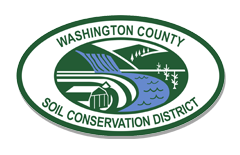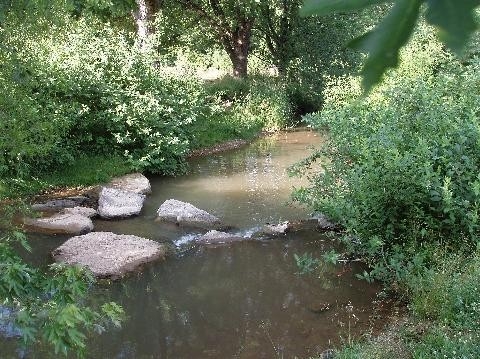The Beaver Creek Stream Restoration project consists of the restoration of approximately 630 linear feet of Beaver Creek in Washington County. The project area is located at the confluence of the main stem of Beaver Creek, a use III trout stream, and the outflow from the Albert S. Powell Fish Hatchery. Construction was completed in May of 1999.
The project area was experiencing severe stream bank erosion and resultant living resource habitat impacts due to overgrazing and increasing urban development in the watershed.
The Barr family approached the Washington County Soil Conservation District with a request for assistance in solving the problems they saw with the stream.
The goal of the project was to eliminate the impacts of the cattle overgrazing and restore the stream channel to a more natural and stable state.
Stream fencing to eliminate access to the stream for cattle, one watering trough to provide an alternate water source for the cattle and roof gutters on the barn up stream of the project site were all installed to protect the water quality in Beaver Creek during and after the project construction phase. Cost share funds for these best management practices were provided from the Maryland Department of Agriculture’s Water Quality Cost Share Program. This program is administered locally by Maryland’s Soil Conservation Districts.
Funding for design and construction as well as tree, shrub and wildflower plantings was secured through the Maryland Department of the Environment, Chesapeake Bay Trust, U.S. Fish and Wildlife Service, Mid Atlantic Federation of Fly Fishers and the Antietam Fly Anglers. Volunteers from the Antietam Fly Anglers assisted with planting of trees and shrubs. H.B. Mellott Estate, Inc. donated 500 tons of rock from their Beaver Creek Quarry to the project.
The project consisted of the construction and realignment of 230 linear feet of the Beaver Creek main stem channel and 400 linear feet of hatchery outflow channel in order to improve the hydrology of the confluence area of both streams. The width of the Hatchery channel was reduced and the floodplain area increased. Rock vanes (with the average rock weighing about 3 tons) were constructed to decrease velocity impacts on stream banks and improve sediment transport. Three rock vanes were placed in Beaver Creek and two were placed in the Hatchery channel. A modified form of Rock vane, called a “J-hook” was also placed in the Hatchery channel. At the confluence of the Beaver Creek and Hatchery channels a “W” vane was placed to protect the hatchery channel from seasonal high water from the main stem of Beaver Creek. A rootwad was salvaged from a tree that had to be removed and placed at one of the bends in Beaver Creek. This structure will help deflect water from the stream bank and hold the soil in place until vegetation has had a chance to take root. In addition to reducing stream bank erosion, all the structures provide excellent fish habitat. Intensive planting of various shrubs and trees within the floodplain area have stopped accelerated erosion and provided aquatic and wildlife habitats.
In May of 2000, 3 acres of land along the creek were planted with hard wood trees and shrubs under the Conservation Reserve Enhancement Program (CREP) further protecting this vital area of Beaver Creek.
Staff from the Washington County Soil Conservation District re-planted trees and shrubs in the stream side areas during 2000-2001 and re-planted the CREP area in 2005.
The project has proven to be effective during flood events in preventing stream side erosion.
Annually the project area has been used to provide training regarding stream restoration techniques as well as being a popular place to demonstrate the benefits of stream restoration to land owners, students and cooperating agencies.
Three interpretive signs have been installed to provide educational opportunities to the public who utilize the site for fishing.




 Back to Top
Back to Top